Tau Antibodies for Alzheimer's Research
In Alzheimer's Disease (AD), Tau proteins form neurofibrillary tangles, a hallmark of AD pathology.
Anti-Tau antibodies target these pathological Tau forms, offering potential diagnostic and therapeutic
applications. They aim to detect Tau levels for diagnosis, inhibit tangle formation, and explore Tau's role
in AD progression.
Summary of Neurodegenerative Diseases
Tau Antigens
Product list of GeneMedi's Tau products
| Catalog No. | Products Name | Biomarker | Fc/Tag | Products Information |
| GMP-h-p-tau181-Ab | Anti-human p-tau181 monoclonal antibody(mAb) | Phospho-tau181 (p-tau181) | hFc/mFc | Details |
| GMP-h-p-tau217-Ab | Anti-human p-tau217 monoclonal antibody(mAb) | Phospho-tau217 (p-tau217) | hFc/mFc | Details |
| GMP-h-p-tau231-Ab | Anti-human p-tau231 monoclonal antibody(mAb) | Phospho-tau231 (p-tau231) | hFc/mFc | Details |
| GMP-h-p-tau202/205-Ab | Anti-human p-tau202 and 205 monoclonal antibody(mAb) | Phospho-tau202 and 205 (p-tau202 and 205) | hFc/mFc | Details |
| GMP-h-p-tau212/214-Ab | Anti-human p-tau212 and 214 monoclonal antibody(mAb) | Phospho-tau212 and 214 (p-tau212 and 214) | hFc/mFc | Details |
| GMP-h-p-tau413-Ab | Anti-human p-tau413 monoclonal antibody(mAb) | Phospho-tau413 (p-tau413) | hFc/mFc | Details |
| GMP-h-p-tau422-Ab | Anti-human p-tau422 monoclonal antibody(mAb) | Phospho-tau422 (p-tau422) | hFc/mFc | Details |
| GMP-h-Tau-Ab | Anti-human Tau monoclonal antibody(mAb) | tau proteins (Tau) | hFc/mFc | Details |
| GMP-h-p-tau181-Ag | Phospho-tau181 (p-tau181) antigen/antigen (full length) | Phospho-tau181 (p-tau181) | Details | |
| GMP-h-p-tau217-Ag | Phospho-tau217 (p-tau217) antigen/antigen (full length) | Phospho-tau217 (p-tau217) | Details | |
| GMP-h-p-tau231-Ag | Phospho-tau231 (p-tau231) antigen/antigen (full length) | Phospho-tau231 (p-tau231) | Details | |
| GMP-h-p-tau202/205-Ag | Phospho-tau202 and 205 (p-tau202 and 205) antigen | Phospho-tau202 and 205 (p-tau202 and 205) | Details | |
| GMP-h-p-tau212/214-Ag | Phospho-tau212 and 214 (p-tau212 and 214) antigen | Phospho-tau212 and 214 (p-tau212 and 214) | Details | |
| GMP-h-p-tau413-Ag | Phospho-tau413 (p-tau413) antigen | Phospho-tau413 (p-tau413) | Details | |
| GMP-h-p-tau422-Ag | Phospho-tau422 (p-tau422) antigen | Phospho-tau422 (p-tau422) | Details | |
| GMP-h-Tau-Ag | tau proteins (Tau) antigen | tau proteins (Tau) | Details |
Validation of GeneMedi's Tau products
GeneMedi provides high-quality diagnostics-grade p-tau181, p-tau217, p-tau231, p-tau202/205, p-tau212/214, p-tau413, and p-tau422 antibodies and antigens for the rapid test kit of neurodegenerative diseases (specifically Alzheimer's Disease) in various formats, including standard substance, positive control, ELISA test, Lateral flow immunoassay (LFIA), colloidal gold immunochromatographic assay, Chemiluminescent immunoassay (CLIA), turbidimetric inhibition immunoassay (TINIA), immunonephelometry, and POCT. GeneMedi's well-validated p-tau181/Tau, p-tau217/Tau, p-tau231/Tau, p-tau202/205/Tau, p-tau212/214/Tau, p-tau413/Tau, and p-tau422/Tau pairs demonstrate excellent diagnostic performance in blood tests for Alzheimer's Disease.
Good performance of GeneMedi's p-tau/tau antibodies in ELISA Validation
1. GeneMedi's three phosphorylated tau protein antibodies (p-tau181, p-tau217, and p-tau231) demonstrate outstanding sensitivity and exceptional specificity with their corresponding phosphorylated forms in direct ELISA assays.
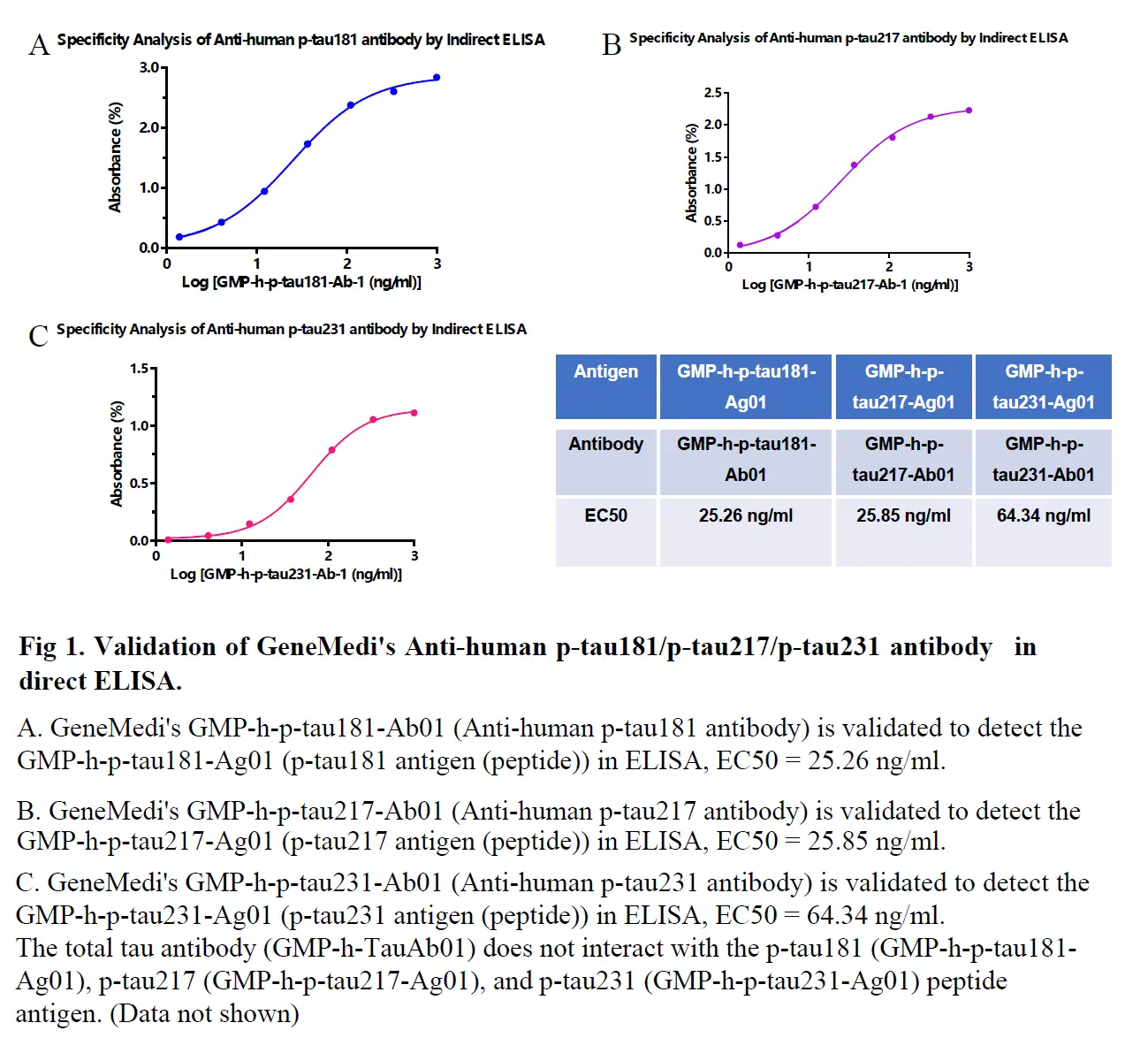
GeneMedi's p-tau antibodies and antigens demonstrate excellent binding affinity: GMP-h-p-tau181-Ab01 effectively binds with GMP-h-p-tau181-Ag01, GMP-h-p-tau217-Ab01 binds well with GMP-h-p-tau217-Ag01, and GMP-h-p-tau231-Ab01 shows strong binding with GMP-h-p-tau231-Ag01. These results indicate that GeneMedi's p-tau antibodies and antigens possess outstanding affinity.
Product used as below:
| Cat NO. | Description |
| GMP-h-p-tau181-Ab01 | Anti-Phospho-tau181 (p-tau181) mouse monoclonal antibody (mAb) |
| GMP-h-p-tau181-Ag01 | Phospho-tau181 (p-tau181) antigen (peptide) |
| GMP-h-p-tau217-Ab01 | Anti-Phospho-tau217 (p-tau217) mouse monoclonal antibody (mAb) |
| GMP-h-p-tau217-Ag01 | Phospho-tau217 (p-tau217) antigen (peptide) |
| GMP-h-tau231-Ab01 | Anti-Phospho-tau231 (p-tau231) mouse monoclonal antibody (mAb) |
| GMP-h-p-tau231-Ag01 | Phospho-tau231 (p-tau231) antigen (peptide) |
Fig 1. Validation of GeneMedi's Anti-human p-tau181/p-tau217/p-tau231 antibody in direct ELISA.
A. GeneMedi's GMP-h-p-tau181-Ab01 (Anti-human p-tau181 antibody) is validated to detect the GMP-h-p-tau181-Ag01 (p-tau181 antigen (peptide)) in ELISA, EC50 = 25.26 ng/ml.
B. GeneMedi's GMP-h-p-tau217-Ab01 (Anti-human p-tau217 antibody) is validated to detect the GMP-h-p-tau217-Ag01 (p-tau217 antigen (peptide)) in ELISA, EC50 = 25.85 ng/ml.
C.
GeneMedi's GMP-h-p-tau231-Ab01 (Anti-human p-tau231 antibody) is validated to detect the GMP-h-p-tau231-Ag01 (p-tau231 antigen (peptide)) in ELISA, EC50 = 64.34 ng/ml.
The total tau antibody (GMP-h-TauAb01) does not interact with the p-tau181 (GMP-h-p-tau181-Ag01), p-tau217 (GMP-h-p-tau217-Ag01), and p-tau231 (GMP-h-p-tau231-Ag01) peptide antigen. (Data not shown)
2. In direct ELISA assays, GeneMedi's phosphorylated tau217 antibody demonstrates excellent sensitivity and precision for both full-length and peptide forms of the phosphorylated tau217 antigen. However, its ability to detect other phosphorylated antigens and total tau antigen is limited, indicating its highly specificity.
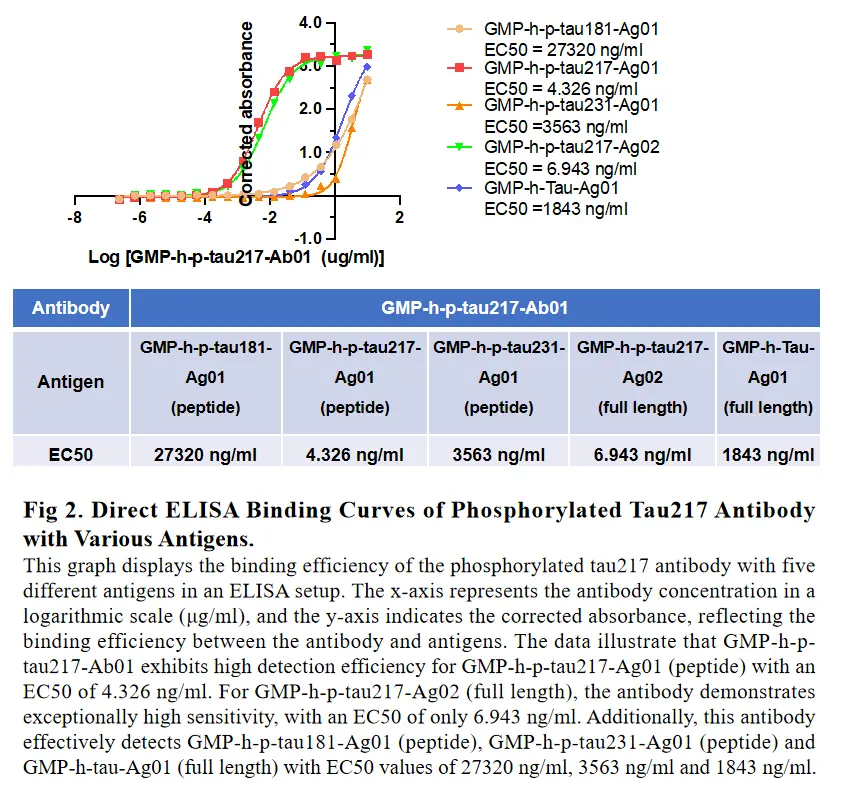
GeneMedi's GMP-h-p-tau217-Ab01 antibody demonstrates excellent binding ability with the full-length antigen GMP-h-p-tau217-Ag02 as well as the peptide GMP-h-p-tau217-Ag01. However, when interacting with the antigens GMP-h-p-tau181-Ag01, GMP-h-p-tau231-Ag01, and GMP-h-Tau-Ag01, the affinity is relatively weaker, as reflected by significant differences in EC50 values. These results indicate that GeneMedi's p-tau 217 antibody exhibits high affinity and specificity. Product used as below:
| Cat NO. | Description |
| GMP-h-p-tau181-Ag01 | Phospho-tau181(p-tau181) antigen (peptide) |
| GMP-h-p-tau217-Ag01 | Phospho-tau217 (p-tau217) antigen (peptide) |
| GMP-h-p-tau231-Ag01 | Phospho-tau231 (p-tau231) antigen (peptide) |
| GMP-h-p-tau217-Ag02 | Phospho-tau217 (p-tau217) antigen (full length) |
| GMP-h-Tau-Ag01 | Recombinant human MAPT/Tau/MAPTL/MTBT1 Protein |
| GMP-h-p-tau217-Ab01 | Anti-Phospho-tau217 (p-tau217) mouse monoclonal antibody (mAb) |
Fig 2. Direct ELISA Binding Curves of Phosphorylated Tau217 Antibody with Various Antigens.
This graph displays the binding efficiency of the phosphorylated tau217 antibody with five different antigens in an ELISA setup. The x-axis represents the antibody concentration in a logarithmic scale (μg/ml), and the y-axis indicates the corrected absorbance, reflecting the binding efficiency between the antibody and antigens. The data illustrate that GMP-h-p-tau217-Ab01 exhibits high detection efficiency for GMP-h-p-tau217-Ag01 (peptide) with an EC50 of 4.326 ng/ml. For GMP-h-p-tau217-Ag02 (full length), the antibody demonstrates exceptionally high sensitivity, with an EC50 of only 6.943 ng/ml. Additionally, this antibody effectively detects GMP-h-p-tau181-Ag01 (peptide), GMP-h-p-tau231-Ag01 (peptide) and GMP-h-tau-Ag01 (full length) with EC50 values of 27320 ng/ml, 3563 ng/ml and 1843 ng/ml.
3. In sandwich ELISA assays, GeneMedi's p-tau217 antibody and tau antibody pair can detect the full-length phosphorylated 217 protein but are unable to detect phosphorylated 217 peptides or non-phosphorylated proteins.
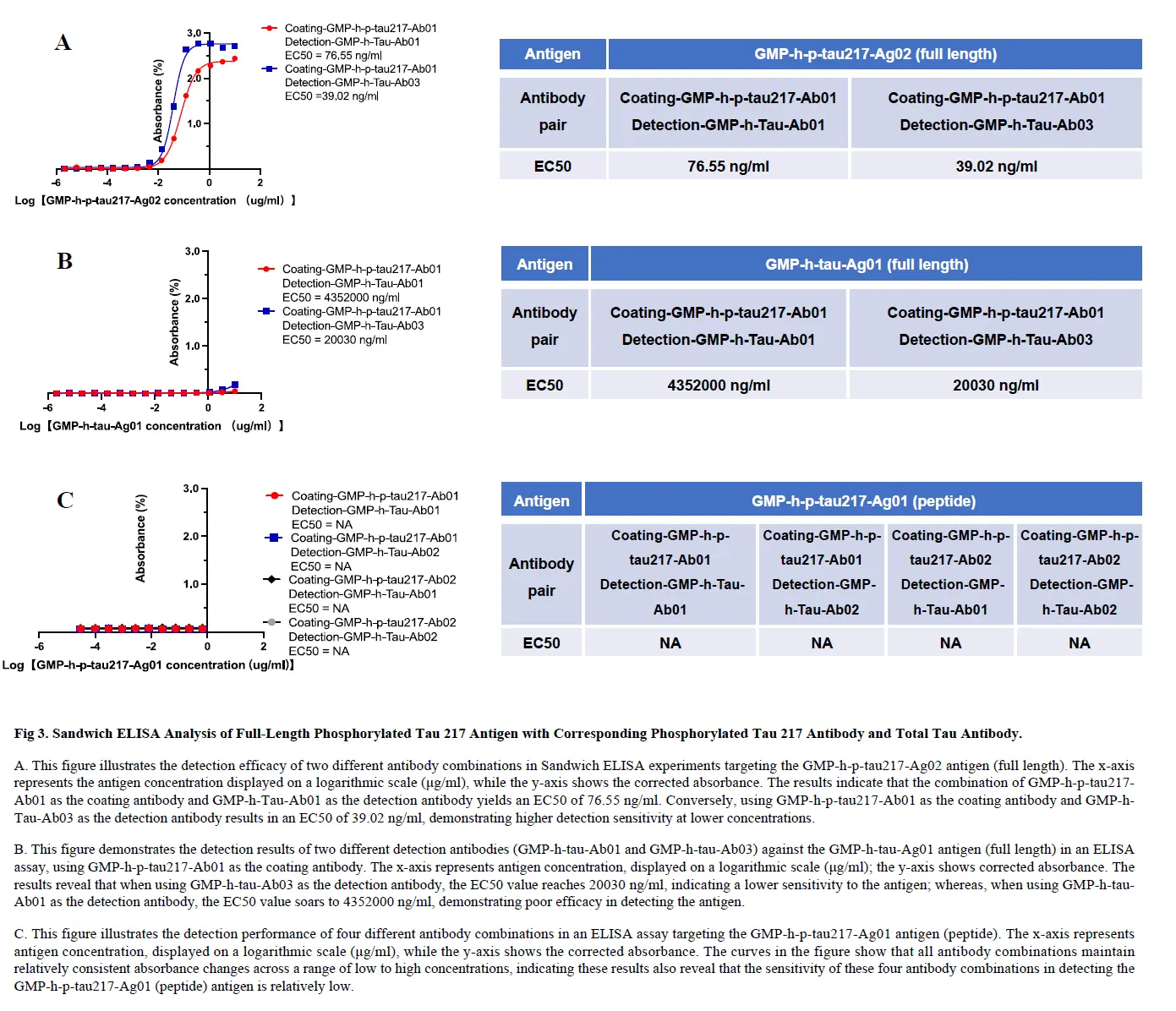
| Cat NO. | Description |
| GMP-h-p-tau217 A g01 | Phospho-tau217 (p-tau217) antigen (peptide) |
| GMP-h-p-tau217 A g02 | Phospho-tau217 (p-tau217) antigen (full length) |
| GMP-h-p-tau217 Ab01 | Anti-Phospho-tau217 (p-tau217) mouse monoclonal antibody (mAb) |
| GMP-h-p-tau217 Ab02 | Anti-Phospho-tau217 (p-tau217) mouse monoclonal antibody (mAb) |
| GMP-h-tau-A g01 | Recombinant human MAPT/Tau/MA PTL/MTBT1 Protein |
| GMP-h-tauA b01 | A nti-human MAPT/Tau/MA PTL/MTBT1 mouse monoclonal antibody (mAb) |
| GMP-h-tau-A b02 | Anti-human MAPTITau/MA PTL/MTBT1 mouse monoclonal antibody (mAb) |
| GMP-h-tau-A b03 | Anti-human MAPTITau/MA PTL/MTBT1 mouse monoclonal antibody (mAb) |
GMP-h-p-tau217-Ab01 is used as the capture antibody. When GMP-h-Tau-Ab03 is used as the detection antibody, the EC50 for detecting GMP-h-p-tau217-Ag02 is lower than GMP-h-Tau-Ab01, indicating GMP-h-Tau-Ab03 is more suitable as a detection antibody.
However, when detecting phosphorylated 217 peptide GMP-h-p-tau217-Ag01 or non-phosphorylated protein GMP-h-tau-Ag01, the EC50 remains high regardless of whether GMP-h-Tau-Ab03 or GMP-h-Tau-Ab01 is used, suggesting no binding for detecting peptide GMP-h-p-tau217-Ag01 or non-phosphorylated protein GMP-h-tau-Ag01 under these conditions.
Fig3. Sandwich ELISA Analysis of Full-Length Phosphorylated Tau 217 Antigen with Corresponding Phosphorylated Tau 217 Antibody and Total Tau Antibody.
A.This figure illustrates the detection efficacy of two different antibody combinations in Sandwich ELISA experiments targeting the GMP-h-p-tau217-Ag02 antigen (full length). The x-axis represents the antigen concentration displayed on a logarithmic scale (μg/ml), while the y-axis shows the corrected absorbance. The results indicate that the combination of GMP-h-p-tau217-Ab01 as the coating antibody and GMP-h-Tau-Ab01 as the detection antibody yields an EC50 of 76.55 ng/ml. Conversely, using GMP-h-p-tau217-Ab01 as the coating antibody and GMP-h-Tau-Ab03 as the detection antibody results in an EC50 of 39.02 ng/ml, demonstrating higher detection sensitivity at lower concentrations.
B.This figure demonstrates the detection results of two different detection antibodies (GMP-h-tau-Ab01 and GMP-h-tau-Ab03) against the GMP-h-tau-Ag01 antigen (full length) in an ELISA assay, using GMP-h-p-tau217-Ab01 as the coating antibody. The x-axis represents antigen concentration, displayed on a logarithmic scale (μg/ml); the y-axis shows corrected absorbance. The results reveal that when using GMP-h-tau-Ab03 as the detection antibody, the EC50 value reaches 20030 ng/ml, indicating a lower sensitivity to the antigen; whereas, when using GMP-h-tau-Ab01 as the detection antibody, the EC50 value soars to 4352000 ng/ml, demonstrating poor efficacy in detecting the antigen.
C. This figure illustrates the detection performance of four different antibody combinations in an ELISA assay targeting the GMP-h-p-tau217-Ag01 antigen (peptide). The x-axis represents antigen concentration, displayed on a logarithmic scale (μg/ml), while the y-axis shows the corrected absorbance. The curves in the figure show that all antibody combinations maintain relatively consistent absorbance changes across a range of low to high concentrations, indicating these results also reveal that the sensitivity of these four antibody combinations in detecting the GMP-h-p-tau217-Ag01 (peptide) antigen is relatively low.
4. GeneMedi's Tau Protein antibodies exhibit remarkable sensitivity and exceptional specificity when tested with GeneMedi’s recombinant human Tau Protein in direct ELISA assays.
Fig4. Validation of GeneMedi's Anti-human Tau antibody.
GeneMedi's GMP-h-Tau-Ab01/03/05/06/07/08/09/10/11/12 (Anti-human Tau antibody) is validated to detect the GMP-h-Tau-Ag01 (Recombinant human Tau Protein) in ELISA.
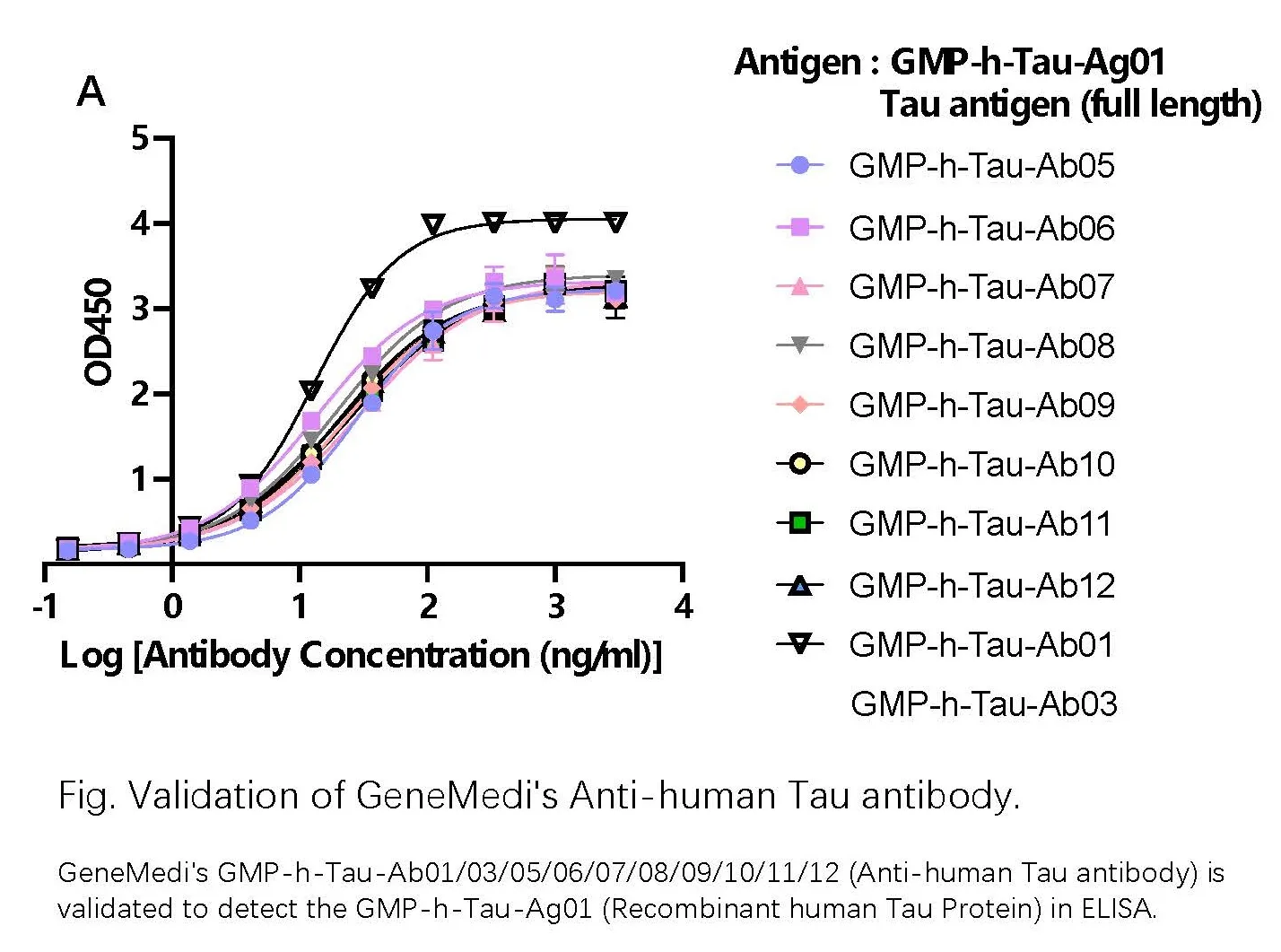
5. In sandwich ELISA assays, GeneMedi's p-tau217/tau antibody pairs can detect the full-length phosphorylated 217 protein but are unable to detect the non-phosphorylated full-length Tau protein
Fig5. Sandwich ELISA Analysis of Full-Length Phosphorylated Tau 217 Antigen with Corresponding Phosphorylated Tau 217 Antibody and Total Tau Antibody.
These figures illustrate the detection efficacy of different antibody combinations in Sandwich ELISA experiments targeting the GMP-h-p-tau217-Ag02 antigen (full length). The results show that when using GMP-h-Tau-Ab01 (A), GMP-h-Tau-Ab03 (B), GMP-h-Tau-Ab05 (C), and GMP-h-Tau-Ab06 (D), GMP-h-Tau-Ab07 (E), GMP-h-Tau-Ab08 (F), GMP-h-Tau-Ab09 (G), GMP-h-Tau-Ab10 (H), GMP-h-Tau-Ab11 (I) and GMP-h-Tau-Ab12 (J) respectively as the detection antibodies, and GMP-h-p-tau217-Ab01/03/05/06 as the coating antibody in each case. As a negative control, when the same antibody pairs target the GMP-h-Tau-Ag01 antigen (full length), the resulting EC50 is NA, which demonstrates their high specificity and sensitivity.
The table shows the EC50 values of different antibody combinations in sandwich ELISA experiments targeting the GMP-h-p-tau217-Ag02 antigen (full-length), as shown in A–J. GMP-h-p-Tau217-Ab06 shows the best EC50 in almost all antibody pairs.
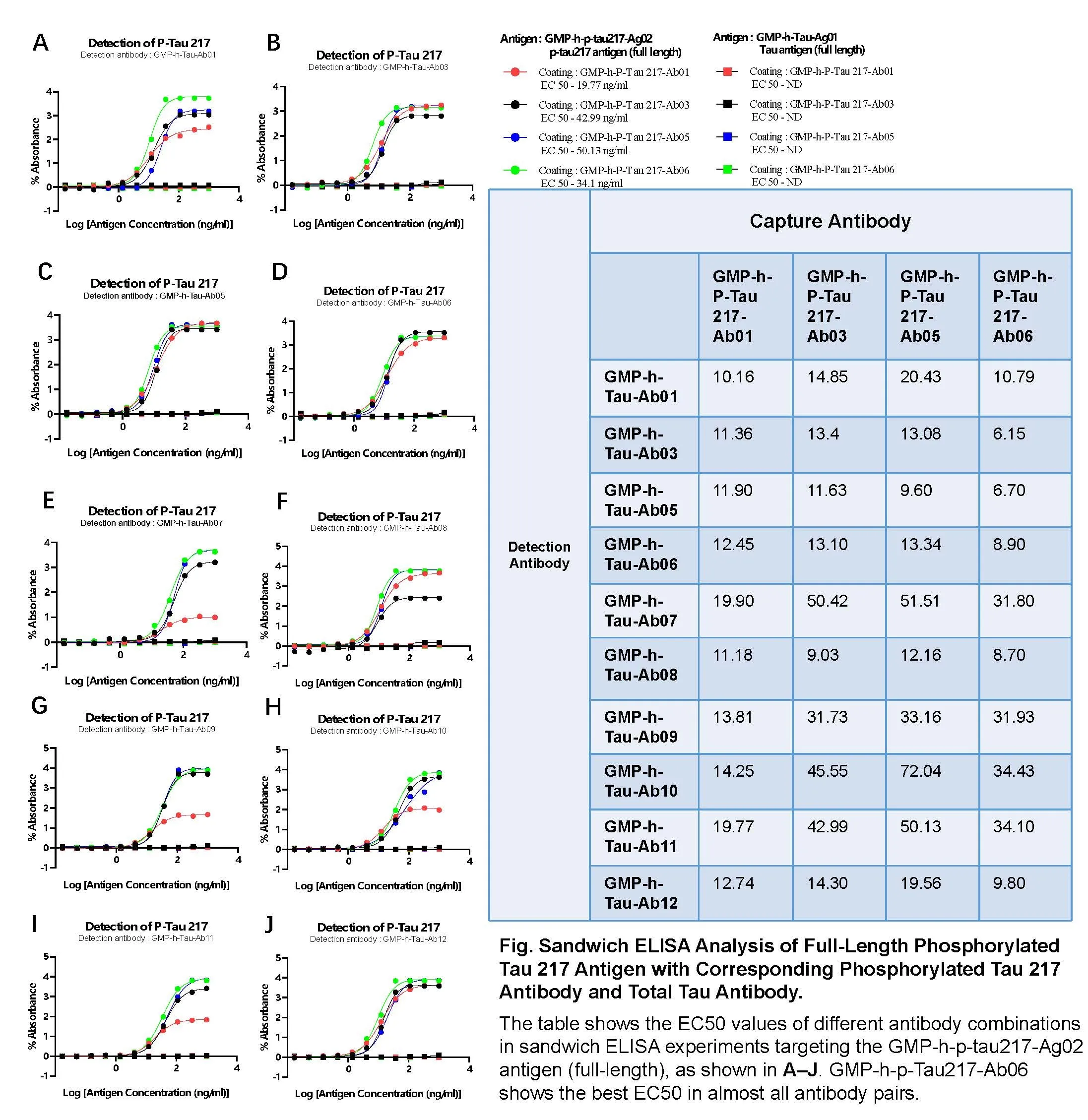
6. Validation of High-Specificity p-Tau217/181/231 and Tau Antibody Pairs
The ELISA validation data demonstrates the exceptional specificity of p-Tau217/181/231 and tau antibody pairs: p-Tau217/Tau pair exclusively recognizes p-Tau217 full-length antigen (Figure A); p-Tau181/Tau pair shows selective binding to p-Tau181 full-length antigen (Figure B); p-Tau231/Tau pair specifically detects p-Tau231 full-length antigen (Figure C). The complete absence of cross-reactivity with non-target phospho-Tau isoforms confirms the superior specificity of these antibody pairs, making them ideal for precise Alzheimer's disease biomarker detection.
Fig6. High specificity and reliability of p-Tau217/181/231 and tau antibody pairs In ELISA.
A. p-Tau217/ tau antibody pair binds specifically to p-Tau217 full-length antigen.
B. p-Tau181/ tau antibody pair binds specifically to p-Tau181 full-length antigen.
C. p-Tau231/ tau antibody pair binds specifically to p-Tau231 full-length antigen.
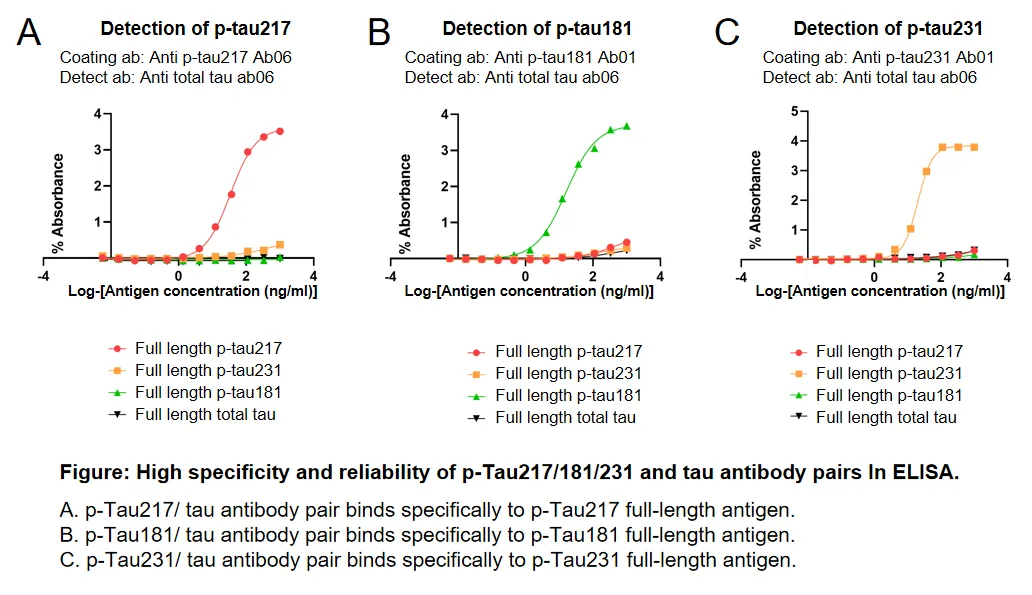
9. High specificity of pTau217/181/231 peptides
GeneMedi provides high-quality pTau217, pTau181, and pTau231 peptides with well-characterized specificity.
As demonstrated in Figures A, B, and C: the pTau217 peptide exhibits selective binding to pTau217 antibodies (Figure A), the pTau181 peptide specifically interacts with pTau181 antibodies (Figure B), and the pTau231 peptide shows exclusive recognition by pTau231 antibodies (Figure C). These data confirm that each peptide is phosphorylated predominantly at its designated site, with negligible cross-phosphorylation at other residues.
Fig9. High specificity and reliability of p-Tau217/181/231 peptides in ELISA.
A. p-Tau217 peptide binds specifically to p-Tau217 antibodies.
B. p-Tau181 peptide binds specifically to p-Tau181 antibodies.
C. p-Tau231 peptide binds specifically to p-Tau231 antibodies.
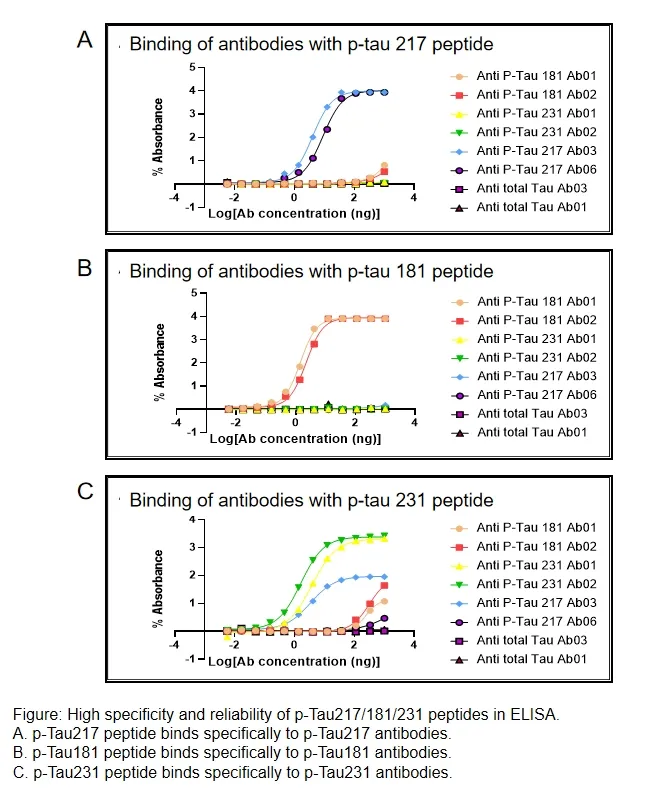
Understanding Tau
In Alzheimer's Disease (AD), Tau proteins play a critical role in the disease's pathology. Normally, Tau helps stabilize microtubules in neuronal cells. However, in AD, abnormal phosphorylation of Tau proteins leads to the formation of neurofibrillary tangles (NFTs) inside neurons, disrupting cell function and contributing to neurodegeneration.
Tau Antigen in AD:
In the context of AD, the Tau antigen refers to the Tau protein itself, particularly its hyperphosphorylated forms found in neurofibrillary tangles. These modified Tau proteins are considered biomarkers for AD, correlating with disease progression and severity. Research into Tau's structure and function in AD has significantly advanced our understanding of the disease and has led to the development of diagnostic methods and potential therapeutic targets.
Anti-Tau Antibodies for AD:
Anti-Tau antibodies are designed to recognize and bind to specific epitopes on Tau proteins. In AD research and treatment, these antibodies have multiple applications:
-
Diagnostic Tools: Anti-Tau antibodies are used in assays to detect elevated levels of Tau proteins in cerebrospinal fluid (CSF) or blood, aiding in the diagnosis of AD and monitoring disease progression.
-
Therapeutic Agents: Several anti-Tau antibodies are being investigated as potential treatments for AD. The rationale is that these antibodies could bind to pathological forms of Tau, preventing or slowing the formation of neurofibrillary tangles, and potentially stopping or reversing neuronal damage. Clinical trials are ongoing to assess the efficacy and safety of these antibodies in AD patients.
-
Research Applications: In the lab, anti-Tau antibodies are invaluable tools for studying the role of Tau in AD pathology, including the mechanisms of Tau aggregation and its effects on neuronal function and survival.
The development of Tau-targeted therapies, including anti-Tau antibodies, represents a promising avenue for Alzheimer's research, with the potential to offer new treatment options for patients suffering from this devastating disease.






